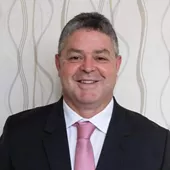Results
The postoperatively result of the two reported cases without significant changes. The patients' chief complaints were successfully addressed. The patients’ concerns regarding postoperative morbidity and treatment time were taken into account, and successfully addressed with less invasive techniques that offered greater treatment agility. In up to 18 months of follow-up, rehabilitation has been successful and no signs of mucositis/peri-implantitis, or active periodontal disease have been observed.
Discussion
After a follow-up of up to 18 months, these implants — placed in the region of the maxillary tuberosity, purposely tilted and splinted with axially placed implants, supporting fixed prostheses that received immediate loading — have shown satisfactory results, similar to those observed in the literature in cases of tilted implants supporting full-arch prostheses. Meta-analysis has suggested that there are no significant differences in terms of marginal bone loss, fracture, or survival between tilted and axial implants; however, in terms of patient comfort, treatment time, and cost, tilted implants appear to be a highly attractive alternative for patients.
The NO SINUS LIFT CONCEPT for fixed partial dentures advocates 1 implant placed in the region of the maxillary tuberosity, intentionally tilted and positioned tangentially to the posterior portion of the posterior wall of the maxillary sinus, with its apical portion facing the posterior face of the tuberosity, and another implant placed axially in the area anterior to the mesial wall of the maxillary sinus, supported by a rigid infra-structure of the fixed partial restoration. Some advantages of this approach can be listed, such as: I) lower biological cost, II) shorter treatment time, and III) lower financial cost. This concept allows the use of longer implants in the posterior region, facilitating the construction of prostheses and avoiding distal cantilevers as these can be related to greater bone loss3,4, unlike other implant angulation techniques. Care should be taken when drilling and placing implants in the tuberosity area, as the natural remodelling of the maxilla occurs from anterior to posterior and from buccal to palatal. These demands the use of long drills, often coupled to an extender, and implants should ideally be placed with a straight handle. In low-density bone, under-preparation of the surgical site is also recommended.
Maxillary sinus lift surgery remains an excellent treatment option when well indicated. Currently, however, there are several treatment options to avoid painful procedures that can also increase treatment morbidity, such as new alloys, short implants, stable connections, different surface treatments, mesio-distal angulation of implants and digital planning with guided surgery to achieve optimum angulation, all of which result in significantly lower morbidity.
The contraindications for tilted implants bypassing the maxillary sinus in the tuberosity area are the same as those considered for conventional implant placement, but it is necessary to carefully evaluate patients with a mouth opening of at least 40 mm , and cases where root/dental remnants may prevent the ideal angulation of implants; minimum maxillary bone height of 10 mm, combined with a minimum width of 5 mm; angulation can vary between 15º and 45º in relation to the occlusal plane; minimal placement torque value of 35 N/cm2.
Successful rehabilitation of the lower arch with immediate implants and immediate loading is already a reality in daily practice. In this case , implants with a surface design that allowed fewer implants to support immediate total prosthesis were used, following the same clinical protocol previously published17.
Conclusion
At the end of up to 18 months follow-up of these posterior maxillary partial rehabilitations with tilted implants in the maxillary tuberosity region receiving immediate loading, our results suggest that it is possible to successfully use implants and prostheses with this technique . Nevertheless, we consider the need for long-term clinical studies with larger case numbers to confirm our findings.
Jaques Luiz
Implantology – Private Practice, Curitiba/PR, Brazil.
Julia Helena Luiz
Periodontology – Private Practice, Curitiba/PR, Brazil
Flavia Sukekava
Periodontology – Private Practice, Curitiba/PR, Brazil
Christian Rado Jarry
Implantology - Instituto Praxis, Brasília/DF, Brazil / Straumann Headquarters, Switzerland




